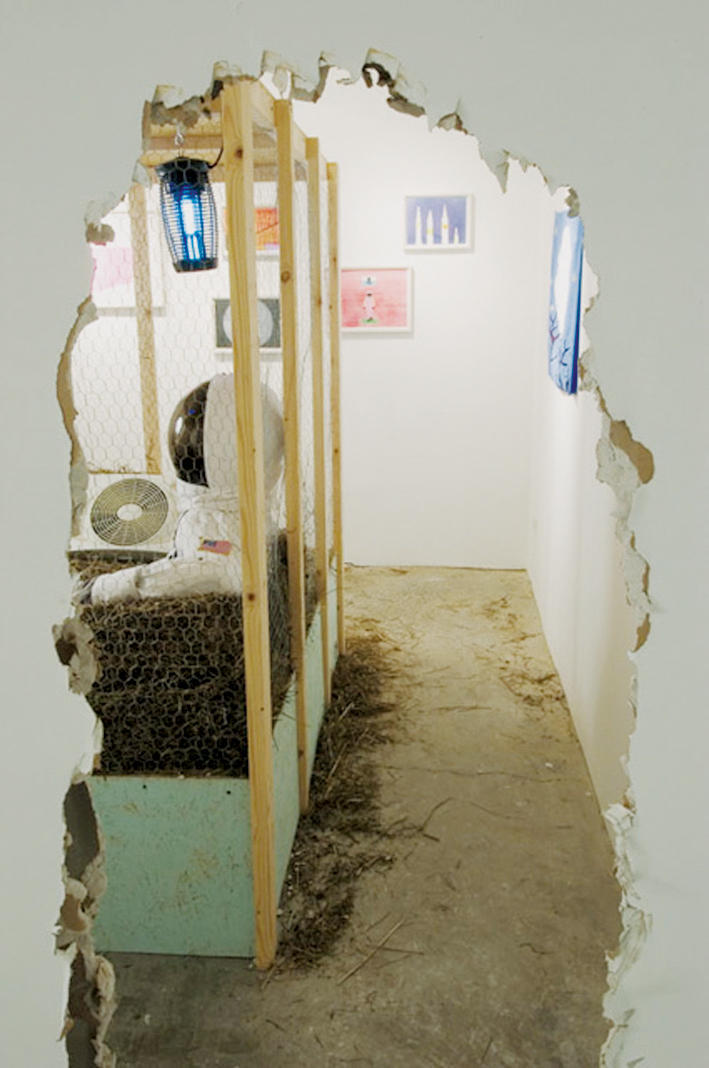
New York
Basim Magdy: In the Grave of Intergalactic Utopia
Newman Popiashvili Gallery
September 9–October 14, 2006
Basim Magdy’s recent solo show at Newman Popiashvili Gallery in New York assembles a constellation of colorful characters and naive forms into a graphics-painting-installation show critiquing the simulated realities of television screens, stories, and fictions.
In the Grave of Intergalactic Utopia is crammed into a small room built by Magdy within the gallery space. Visitors entered through a hole torn out of the wall to find an installation of a downed astronaut condemned to a filthy chicken coop to watch a video loop of an unremarkably bucolic landscape. Surrounding the cage, on the walls of the room, Magdy’s works on paper featured apes, blobs, and spacemen floating through weathered neon colors like unemployed pop icons lost midway between fiction and form. They seemed to have once stood for hope and day-glo levity, and though they may still, they seem to have forgotten why. They recalled images from a youth spent looking at pixelated screens: an astronaut perched on the tip of an airplane’s wing as if considering jumping off, a bored-looking ape amidst parachutists in bubbles, a gorilla-boy who has just caught a fish, a face peering from a kind of giant anthill with soldiers peering over a bright picket fence, a fabric of a sickly-looking moon, a monkey on a vine in front of blood-red sky, a mysterious astronaut who approaches under a skull and crossbones flag wearing a strange pink fur coat.
The sarcastic neon palette (not to mention the surveillance Magdy installed in the space) reminds us that television owns the moment, and that his images are transmissions from either screen, dream, or something in the middle. The threat of war is there, but it’s a banal war, the references deliberately hazy and superficial.
Magdy’s bright, poppy melancholia is less interested in political events than in a kind of suspended inability to sense circumstances surrounding those same events. This has the unfortunate tendency to come across as a kind of detached generational statement, and where this is concerned, Magdy’s supposition that the children of television are defeated, emaciated subjects risks being itself a bit tired.
However, in working with ideas of broken memories and cultural pollution, Magdy’s works do not attempt to reclaim any originary natural order any more than they bother to produce anything out of their estrangement. Magdy stands firmly by the space he has built between fiction and reality because, perhaps, there are no alternatives. It is his deliberate use of this middle space — where fiction tugs at the world and the world tugs back — that makes his work interesting. A grave for utopia, to borrow from the title of Magdy’s show, suggests a gap dividing social consciousness from possibilities lying in alternate narratives — an end for dreaming. Inside this gap, Magdy finds that, as dreams perceive their own uselessness and begin fading away, a change takes place within their chemistry. As they die, dreams begin to generate their own images.
In Magdy’s work, it is as if possible worlds once connected to the real world in a fluid continuum, as a child could once have expected fictional characters on television to gracefully translate seamlessly with age to other meaningful forms. Instead, the characters from films and fictions simply empty out. Astronauts and wise animal narrators continue their narration, but they tell useless stories. If these stories are useless — if traveling into space is about expansionism and not wonder, and superheroes are about masturbation and not personal strength — if Disney, NASA, and Spielberg are about brutal industry and not awe, then Magdy insists upon following the dreams they produce a bit further as they shed their capacity to inspire wonder.